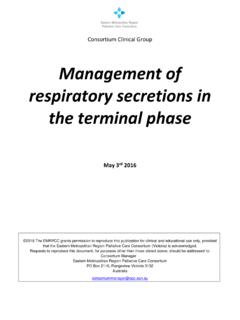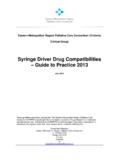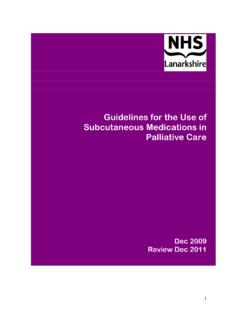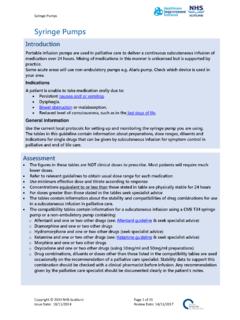Transcription of Opioid Conversion Ratios Guide to Palliative Care …
1 Opioid Conversion Ratios Guide to Palliative care Practice 2016 3/5/2016 2016. The EMR PCC grants permission to reproduce parts of this publication for clinical and educational use only, provided that the Eastern Metropolitan Region Palliative care Consortium is acknowledged. Requests to reproduce this document, for purposes other than those stated above, should be addressed to: Consortium Manager Eastern Metropolitan Region Palliative care Consortium PO Box 2110 Rangeview 3132 Victoria Australia Eastern Metropolitan Region Palliative care Consortium (Victoria) Opioid Conversion Ratios - Guide to Palliative care Practice 2016 2016. It is highly recommended this Guide is printed in colour, to aid ease of use. The access point for the current electronic version of the Guide is Eastern Metropolitan Region Palliative care Consortium or Centre for Palliative care Printed versions can only be considered up-to-date for a period of one month from the printing date after which, the latest version should be downloaded ACKNOWLEDGEMENTS EMRPCC Opioid Conversion Guide Review 2016 Project officer: Ms S Scholes, BPharm Grad Cert Heath ( Palliative care ) MSHP Victorian Palliative Medicine Specialists: Dr P Poon; Dr M Benson; Dr M Franco and Dr L William who provided fresh perspectives on the 2016 document.
2 EMRPCC Clinical Group (2016): Eastern Health: Dr L William ( Palliative Medicine Specialist), Ms J Wilkinson & Ms D Bach (Clinical Nurse Consultants) Eastern Palliative care Association Inc: Mr D Halliwell (Clinical Nurse Consultant) St Vincent s Health Melbourne & Eastern Palliative care Association Inc: Dr P Sherwen ( Palliative Medicine Specialist) St Vincent s Health Melbourne: Mr T Whelan (Nurse Practitioner) Eastern Metropolitan Region Palliative care Consortium: Ms C Clifton (Consortium Manager) Special Acknowledgments: Ms A Padrissa & Ms K McGrath, Eastern Health (Wantirna Health) Palliative care Pharmacists Ms S Chung, St Vincent s Hospital (Melbourne), Medicines Information Pharmacist (Covering) Acknowledgement for previous documents: Acknowledgment is also extended to the original 2008 EMRPCC clinical group and all contributors to the initial EMRPCC Opioid Conversion Ratios Guide to Practice (October 2008) and the members of the EMRPCC clinical groups who revised the document EMRPCC Opioid Conversion Ratios - Guide to Practice (December 2010 and again in July 2013).
3 The EMRPCC welcomes feedback. Please send comments to: Consortia Manager, Eastern Metropolitan Region Palliative care Consortium PO Box 2110 Rangeview Victoria Australia 3132 or email Eastern Metropolitan Region Palliative care Consortium (Victoria) Opioid Conversion Ratios - Guide to Palliative care Practice 2016 2016. Contents ACKNOWLEDGEMENTS .. 2 DISCLAIMER .. 4 GENERAL NOTES .. 4 ORAL MORPHINE TO OTHER ORAL OPIOIDS .. 5 ORAL OPIOIDS TO SUBCUTANEOUS OPIOIDS same drug to same 5 SUBCUTANEOUS MORPHINE TO OTHER SUBCUTANEOUS OPIOIDS .. 6 MORPHINE TO TRANSDERMAL FENTANYL .. 6 Conversion Guide FOR Opioid TO TRANSDERMAL FENTANYL .. 7 SUBCUTANEOUS FENTANYL TO TRANSDERMAL FENTANYL - same drug to same drug .. 7 TRANSMUCOSAL FENTANYL .. 7 TRANSDERMAL BUPRENORPHINE TO ORAL MORPHINE .. 8 METHADONE .. 8 ORAL METHADONE TO SUBCUTANEOUS METHADONE same drug to same drug .. 9 REFERENCES 2016 .. 10 Summary Chart .. 11 Eastern Metropolitan Region Palliative care Consortium (Victoria) Opioid Conversion Ratios - Guide to Palliative care Practice 2016 2016.
4 Page 4 of 12 DISCLAIMER GENERAL NOTES The conversions are applicable in pain for Palliative care patients rather than patients with chronic pain It is recommended that opioids be converted to the equianalgesic oral morphine as the first step, except when converting from the same drug to the same drug ( oral to subcutaneous) When converting, calculate the equianalgesic starting dose of the new Opioid using the guidelines Apply a dose reduction of 25% to 50% to the equianalgesic starting dose to allow for cross-tolerance A dose reduction closer to 50% is appropriate if the patient is elderly or medically frail Also consider o dose and duration of previous Opioid treatment o current pain severity o patient s ethnicity, for example, oxycodone may be metabolised differently by Caucasian, Asian and North African groups due to genetic polymorphism o renal function, for example, use caution in mild to moderate renal impairment with hydromorphone, morphine and oxycodone.
5 Consensus guidelines suggest fentanyl is the Opioid of choice in severe renal impairment o hepatic function, for example, decrease the dose and frequency of administration of morphine in hepatic failure, and avoid oxycodone in severe cirrhosis. Fentanyl is preferred in moderate to severe liver failure or cirrhosis o occurrence of adverse effects o direction of switch of Opioid , methadone to morphine Prescribe prn breakthrough Opioid during the titration process of 1/10th to 1/6th of the total daily Opioid dose Frequently monitor for patient response and individual dose titration (References 1,2,3) The information in this document is to be used as a Guide to practice only. It is the responsibility of the user to ensure the information is used correctly. This Guide reflects current Palliative care practice in the Eastern Metropolitan Region of Melbourne and published evidence at the time of the review.
6 The current electronic version of the document is available at and should always be referred to. All medication doses derived from this Guide to practice, should be checked and prescribed by a medical doctor or nurse practitioner with appropriate experience in Opioid prescribing. Opioids may be given via different routes as part of clinical practice, to reflect clinical needs, however not all routes ( intrathecal) have been covered in this Guide . Medication doses should be modified in response to the patient/client s clinical situation and status, including previous exposure to opioids and concurrent medications. All patients should be monitored closely until stable when commencing, adjusting dosage and/or switching Opioid medications. Adhere to all legislation and professional requirements including organisational policies and procedures regarding Opioid medications and their administration. Eastern Metropolitan Region Palliative care Consortium (Victoria) Opioid Conversion Ratios - Guide to Palliative care Practice 2016 2016.
7 Page 5 of 12 ORAL MORPHINE TO OTHER ORAL OPIOIDS Oral To Oral Conversion Ratio Example Comments Reference Morphine to Codeine 1:10 Oral Morphine 6mg = Oral Codeine 60mg Avoid Conversion and treat as Opioid na ve Codeine has a limited role in managing moderate-severe pain in Palliative care 3,4,5,6 Morphine to Hydromorphone 5:1 Oral Morphine 5mg = Oral Hydromorphone1mg 3,4,5 Morphine to Methadone Palliative care Specialist input required See Methadone on pages 8-9 for more information Morphine to Oxycodone :1 Oral Morphine 15mg = Oral Oxycodone 10 mg The oxycodone component of Targin should be considered in conversions. If doses greater than Targin 80/40 mg per day are required, single entity modified release oxycodone should be used. Note the beneficial effect of naloxone on bowel function may be impaired 3,4,5,6,7 Morphine to Tapentadol 1:3 Oral Morphine 100mg = Oral Tapentadol 300mg 3,8,9 Morphine to Tramadol 1:5 to 1:10 Oral Morphine 10mg = Oral Tramadol 50 to100mg Tramadol has a limited role in managing moderate to severe pain in Palliative care 3,4,6 ORAL OPIOIDS TO SUBCUTANEOUS OPIOIDS same drug to same drug Oral Subcutaneous Conversion Ratio Example Comments Reference Morphine Morphine 2:1 to 3:1 Oral Morphine 30mg = Subcutaneous Morphine 10 to 15mg 3,4,6 Oxycodone Oxycodone :1 to 2:1 Oral Oxycodone 30mg = Subcutaneous Oxycodone 15 to 20mg 3,4,6 Hydromorphone Hydromorphone 2:1 to 3:1 Oral Hydromorphone 15mg = Subcutaneous Hydromorphone 5 to 3,4,6 Eastern Metropolitan Region Palliative care Consortium (Victoria) Opioid Conversion Ratios - Guide to Palliative care Practice 2016 2016.
8 Page 6 of 12 SUBCUTANEOUS MORPHINE TO OTHER SUBCUTANEOUS OPIOIDS Subcutaneous Subcutaneous Conversion Ratio Example Comments Reference Morphine Fentanyl 100:1 Subcutaneous Morphine 10,000 micrograms (10mg) = Subcutaneous Fentanyl 100 micrograms The 100:1 Conversion ratio is conservative 3,10 Morphine Hydromorphone 5:1 Subcutaneous Morphine 10mg = Subcutaneous Hydromorphone 2mg 3,4,6 Morphine Oxycodone 1:1 Subcutaneous Morphine 10mg = Subcutaneous Oxycodone 10mg 3,4 Morphine Sufentanil 1000:1 Subcutaneous Morphine 10,000micrograms (10mg) = Subcutaneous Fentanyl 100micrograms = Subcutaneous Sufentanil 10micrograms Convert to fentanyl initially 11 MORPHINE TO TRANSDERMAL FENTANYL Oral Morphine (mg/24 hours) Subcutaneous Morphine (mg/24 hrs) (Dose ratio 3:1 to 2:1) Transdermal Fentanyl (mcg/24 hours) (Dose ratio from oral morphine 100:1) Transdermal Fentanyl (mcg/ hour) Patch Size Reference 30 10 to 15 300 12 3,12 60 20 to 30 600 25 3,12 120 40 to 60 1200 50 3,12 180 60 to 90 1800 75 3,12 240 80 to 120 2400 100 3,12 Seek specialist Palliative care advice when converting at high doses Eastern Metropolitan Region Palliative care Consortium (Victoria) Opioid Conversion Ratios - Guide to Palliative care Practice 2016 2016.
9 Page 7 of 12 Conversion Guide FOR Opioid TO TRANSDERMAL FENTANYL From To Transdermal Fentanyl 4 hour immediate release (IR) oral Opioid Give regular doses IR oral Opioid for the first 12 hours after applying patch 12 hour controlled release (CR) long acting oral Opioid Apply the patch at the same time as administering the final 12 hour (CR) dose 24 hour controlled release (CR) long acting oral Opioid Apply the patch twelve hours after administering the final 24 hour (CR) dose Continuous subcutaneous infusion morphine (syringe driver) Continue the syringe driver unchanged for 8 to 12 hours after applying the patch, then cease Continuous subcutaneous infusion fentanyl (syringe driver) Continue the syringe driver at the same rate for 6 hours after applying the patch, then cease Effective systemic analgesic concentrations are generally reached in less than 12 hours for fentanyl after applying patch (4,13) SUBCUTANEOUS FENTANYL TO TRANSDERMAL FENTANYL - same drug to same drug Subcutaneous Transdermal Conversion Ratio Example Reference Fentanyl Fentanyl 1:1 Fentanyl 600micrograms / 24 hours = Fentanyl patch 25micrograms/hour 10,14 TRANSMUCOSAL FENTANYL Fentanyl transmucosal products ( lozenges, sublingual and orally-disintegrating tablets) are available for breakthrough cancer pain not adequately managed by other short acting opioids.
10 These products are not interchangeable as they have different pharmacokinetics, therefore titration from baseline (de novo) is required when switching products. Transmucosal fentanyl products offer a faster onset of relief than oral morphine in breakthrough pain and should only be used in patients who are already receiving opioids and are Opioid tolerant. A patient should be receiving at least 60mg of oral morphine equivalents per day or 25 to 50 micrograms transdermal fentanyl per hour, if transmucosal fentanyl is to be considered for breakthrough pain. There is no direct Conversion ratio between morphine and transmucosal fentanyl. Refer to Product Information and the Pharmaceutical Benefits Scheme for further information Eastern Metropolitan Region Palliative care Consortium (Victoria) Opioid Conversion Ratios - Guide to Palliative care Practice 2016 2016. Page 8 of 12 TRANSDERMAL BUPRENORPHINE TO ORAL MORPHINE Patch Strength Delivery Rate Conversion Ratio Calculation Comments Reference Buprenorphine 5mg / 7 days (120 micrograms / 24 hours) 5 micrograms / hour 1:75 1:100 5mg patch = 5 micrograms buprenorphine per hour 5mcg x 24 = 120 micrograms over 24 hours 120microgram buprenorphine x 75 = 9,000 micrograms (9 mg) or x 100 = 12,000 micrograms (12mg) of oral morphine Oral Morphine dose 9 to 12mg/24hours 3,5 Buprenorphine 10mg / 7 days (240 micrograms / 24 hours) 10 micrograms / hour 1:75 1:100 10mg patch = 10micrograms buprenorphine per hour 10microgram x 24 = 240micrograms over 24 hours 240microgram buprenorphine x 75 = 18,000micrograms (18mg) or x 100 = 24,000micrograms (24 mg) of oral morphine Oral Morphine dose 18 to 24mg/24 hours 3,5 Buprenorphine 20mg / 7 days (480 micrograms / 24 hours) 20 micrograms / hour 1:75 1.










![[P] Clonazepam - Palliative Care](/cache/preview/7/3/1/8/c/1/0/f/thumb-7318c10f561f7c7ba618d52f79801a4d.jpg)
